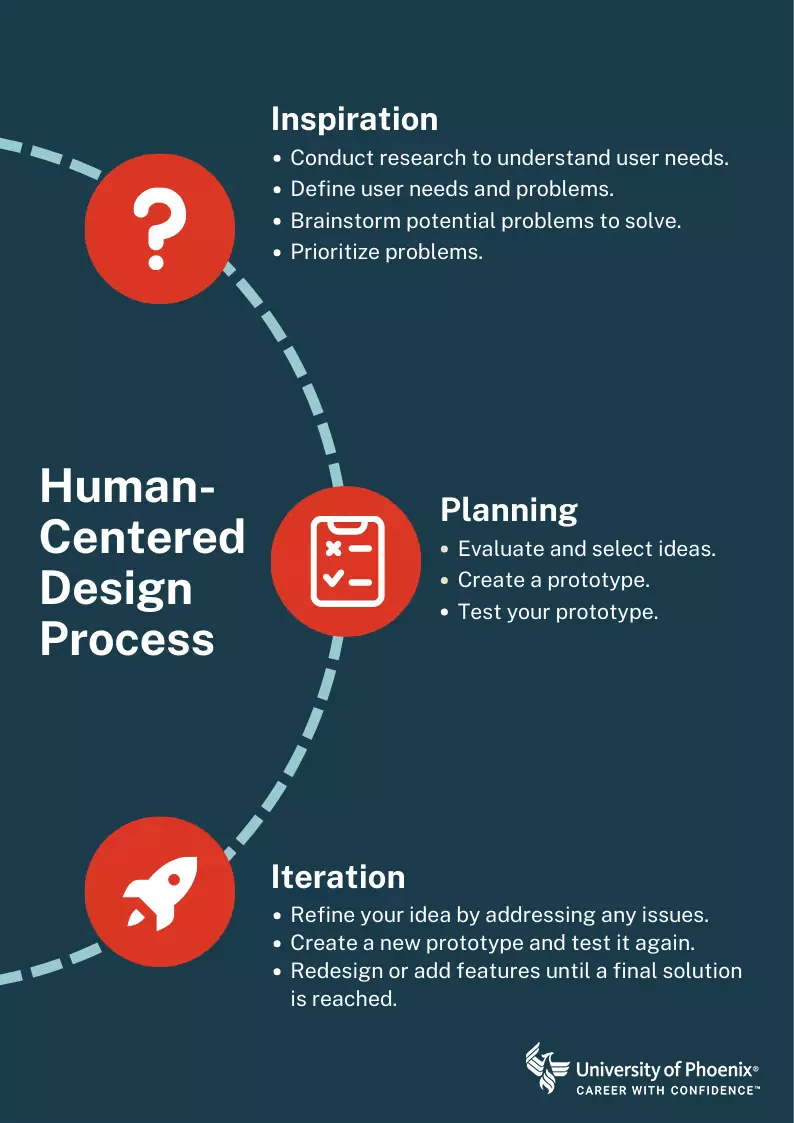What is human-centered design?

Written by Michael Feder

Reviewed by Kathryn Uhles, MIS, MSP, Dean, College of Business and IT

Human-centered design (HCD) is a design thinking method that puts people at the center of the creation, problem-solving and design process. It advocates for understanding people’s needs, desires and behaviors and then innovating solutions or products for them. Whether a business is creating a product or service from the ground up or focusing on product innovation and development, HCD can be a critical part of the process.
Human-centered design principles
The concept of human-centered design has roots in the broader philosophy of design thinking, which involves approaching problems from a user-focused perspective. It’s a process of empathizing with users, defining their needs, ideating solutions, prototyping, testing and iterating. HCD adds a layer of specificity, emphasizing a true understanding of users’ needs before designing solutions.
To create an end product that truly resonates with users, human-centered design relies on the following core principles:
- Designing for the audience: Who are the users, what do they need and what are their pain points?
- Choosing the right problem to solve: Sometimes the initial problem isn’t the actual issue. HCD encourages the iterative redefinition of problems based on feedback.
- Thinking about the whole system: Consider the entire user journey and broader user experience, not just isolated pain points.
- Prototyping and testing the solution: Constantly refine and enhance the solution based on honest user feedback.
Design-thinking principles ensure that designers are open to feedback and as adaptive as possible. This can be done by asking:
- Will users be able to remember how to perform infrequent tasks?
- Will users feel overloaded with tasks or information?
- While resolving some errors and failures, will new errors and failures be created?
- Users’ concerns and characteristics are not organized in the same manner as, for example, software programs and computer systems.
How does the human-centered design process work?
There is no one step-by-step approach for applying HCD, as each project is unique and has its own number of stages to progress through. However, a typical framework involves the following stages:
Inspiration
Inspiration comprises the initial research and understanding of user needs. Here, designers must learn more about what needs they’re trying to fulfill. A few critical steps in this process are:
- Conduct research: This could involve interviews, surveys, ethnographic studies or observation of users interacting with existing products or services.
- Define user needs and problems: This crucial step helps clarify a specific need and directs the design process.
- Brainstorm potential problems to solve: After defining user problems, look at them from different perspectives and think about new ways to approach them.
- Prioritize problems: After making a list of possible issues to address, prioritize them. Consider the impact of solving each problem and how feasible it is to do so.
Once the primary problem is chosen, it becomes the focus of design efforts moving forward.
Planning
After identifying a problem worth solving, it’s time to brainstorm, prototype and refine. Here’s what this process might look like:
- Ideation: To gather as many ideas as possible, explore techniques like mind mapping, sketching or role-playing.
- Selection of ideas: Evaluate each idea based on its potential impact, feasibility and alignment with user needs. Select the most promising ideas to take forward into the prototyping phase.
- Prototyping: Create a tangible representation of the ideas. This could be a sketch, 3D model, storyboard or a digital mock-up. The goal is to bring the solution to life in the simplest and quickest way possible to start testing.
- User testing: Put the prototype in users’ hands. Observe how they interact with it, ask them for their thoughts and feelings, and take note of difficulties they encounter.
- Refining and iterating: Make adjustments to address issues users encounter or to meet their needs better. Then, create a new prototype and test it again.
The idea is likely go through several prototyping, testing and refining cycles.
Iteration
As a prototype is refined, revisit the earlier stages and adjust as needed. For instance, if a product needs more features than anticipated, go back and reevaluate the approach. The existing prototype may need a redesign or added features.
Through this iterative process, walk and rewalk through each stage in order to arrive at the right solution.
Examples of successful human-centered design in business
Here are a few areas where HCD has made a beneficial impact:
- Technology: At least one major technology brand makes impressive products that emphasize intuitive interfaces, elegant design and integrated ecosystems for a functional and pleasurable user experience.
- Retail: One online retailer has become the go-to platform for online shopping because it makes the process as easy and fast as possible for customers. From one-click ordering to detailed product reviews, user experience is at the forefront of this company’s business approach.
- Food delivery: A popular ride-share company created a component for their app that makes ordering food easier and faster than ever, allowing customers to pick their meals from various restaurants and pay through the app.
These examples demonstrate the power of human-centered design for a local and worldwide community.
The role of collaboration in human-centered design
Human-centered design is a highly collaborative process that relies heavily on soft skills, such as teamwork, communication and empathy. Here’s why soft skills are so important:
- Different people bring different ideas, insights and perspectives, helping to identify potential biases and blind spots.
- Communication among team members is key for understanding user needs, generating ideas and creating a unified vision for the product or service.
- Teamwork, scrum meetings and ongoing communication helps ensure everyone is aligned on the design process and helps move projects forward efficiently.
When a team works well together, they are well positioned to create solutions that genuinely resonate with users.
Challenges and limitations of human-centered design
Human-centered design is not without its challenges and limitations, including:
- Biases: All humans are subject to cognitive biases, and designers are no exception. For instance, confirmation bias might cause a designer to pay more attention to user feedback that supports their preexisting assumptions while disregarding other equally valid but less familiar feedback. These biases can distort the design process and lead to solutions that don’t accurately reflect all users’ needs.
- Resource constraints: HCD can be resource intensive. Small businesses or startups might find it challenging to allocate sufficient resources to fully implement HCD. It might also be difficult to quantify the return on investment for these activities, which can make it harder to justify them to stakeholders.
- Resistance to change: Implementing HCD often involves a shift in mindset and practices for an organization. Some members might resist this change, especially if they’re used to more traditional, top-down decision-making.
While implementing HCD can be a long, difficult process, it’s worth the pursuit for a more comprehensive and useful solution or product.
Human-centered design and other business skills
Are you interested in learning more about human-centered design and other business skills you can use on the job? If you have a busy schedule but want to go back for a degree, University of Phoenix offers flexible online business programs with fixed tuition. Explore which program aligns with your goals.
Read more articles like this:

ABOUT THE AUTHOR
A graduate of Johns Hopkins University and its Writing Seminars program and winner of the Stephen A. Dixon Literary Prize, Michael Feder brings an eye for detail and a passion for research to every article he writes. His academic and professional background includes experience in marketing, content development, script writing and SEO. Today, he works as a multimedia specialist at University of Phoenix where he covers a variety of topics ranging from healthcare to IT.

ABOUT THE REVIEWER
Currently Dean of the College of Business and Information Technology, Kathryn Uhles has served University of Phoenix in a variety of roles since 2006. Prior to joining University of Phoenix, Kathryn taught fifth grade to underprivileged youth in Phoenix.
This article has been vetted by University of Phoenix's editorial advisory committee.
Read more about our editorial process.



